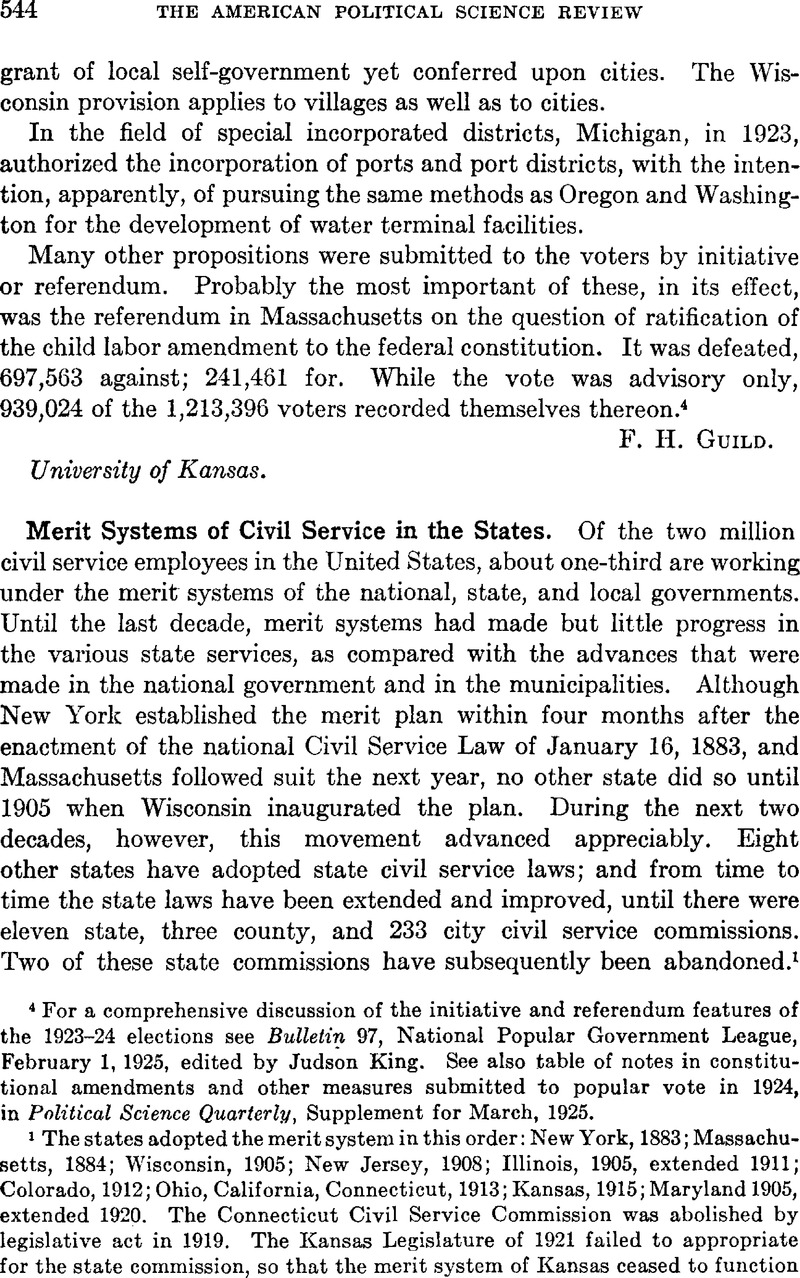No CrossRef data available.
Published online by Cambridge University Press: 02 September 2013

1 The states adopted the merit system in this order: New York, 1883; Massachusetts, 1884; Wisconsin, 1905; New Jersey, 1908; Illinois, 1905, extended 1911; Colorado, 1912; Ohio, California, Connecticut, 1913; Kansas, 1915; Maryland 1905, extended 1920. The Connecticut Civil Service Commission was abolished by legislative act in 1919. The Kansas Legislature of 1921 failed to appropriate for the state commission, so that the merit system of Kansas ceased to function in 1922, leaving only nine states maintaining the merit plan. The county commissions are those of Los Angeles, Milwaukee, and Cook County (Chicago).
2 Procter, A. W., Principles of Public Personnel Administration, p. 195.Google Scholar A similar classification of the municipal civil service commissions is given on pp. 196–200.
3 For a discussion of the constitutional basis of state civil service, see Dr.Arneson, Ben A.: Constitutionality of Merit System Legislation, in American Political Science Review, XIII, (1919) pp. 593–606.CrossRefGoogle Scholar The theory, principles and practice of state civil service organizations is treated fully in Wright's, B. F. monograph on The Merit System in American States with special reference to Texas, University of Texas Bulletin No. 2305, (1923), pp. 1–114.Google Scholar On the general position of “The Civil Service in the Modern State,” see article by Herman Finer in the American Political Science Review, XIX, 277 (1925).
4 Colorado, Session Laws (1919) p. 143.Google Scholar
5 Massachusetts, Acts (1918) p. 131.Google Scholar
6 Ibid. (1919) Chaps. 349–350.
7 Ibid., (1920) pp. 347, 492, 528, 518.
8 New Jersey Session Laws (1918) pp. 94–95, 158–159, 245, 776.
9 Ibid. (1919) pp. 361–362.
10 Ibid. (1920) pp. 181, 370, 331.
11 Telford, Fred, “The One Man Civil Service Commission in Maryland,” National Municipal Review, XII, No. 7 (1923) pp. 358–362.CrossRefGoogle Scholar
12 Maryland, Session Laws (1920) Ch. 41, pp. 75–89.Google Scholar
13 New York Session Laws (1920) pp. 574, 492, 498.Google Scholar
14 Illinois Session Laws (1919) p. 291.Google Scholar
15 Wisconsin, Session Laws (1919) p. 177.Google Scholar
16 Kansas, Session Laws (1921) p. 440.Google Scholar
17 Ohio, Legislative Acts (1921) pp. 132–133.Google Scholar
18 Acts of Arkansas (1921) pp. 65–66.
19 Territory of Hawaii Session Laws (1921) p. 177.Google Scholar
20 New Jersey Session Laws (1922) p. 200.Google Scholar
21 Idaho, Session Laws (1923) Ch. 128.
22 Vol. XIV, 220 (April, 1925.)
23 Report on the Classification and Standardization of the Personnel Service in the New Jersey State Government (1917) p. 7.
24 Sixth Annual Report of the state Civil Service Commission of Ohio (1918) pp. 4–5.
25 This report was prepared by Dr. L. D. Upson, of the Detroit Bureau of Government Research, and Mr. Harrington Place.
26 Eighth Annual Report of the State Civil Service Commission of Ohio (1920) p. 5.
27 Third Biennial Report of the California State Civil Service Commission (1918) p. 9.
28 Report of the Virginia Commission on Economy and Efficiency, (1918) p. 43.
29 Report of the New York Reconstruction Commission on Retrenchment and Reorganization in the State Government (1918) p. 15.
30 New York Civil Service Commission Report (1920) pp. 9–10.
31 Fourth Report of the Connecticut State Civil Service Commission (1918) p. 6.
32 Thirty-sixth Annual Report of the Civil Service Commission of Massachusetts, (1919) p. 16.
33 Annual Report, Commissioner of Civil Service of Massachusetts, (1921) p. 9.
34 Ibid., p. 11.
35 Ibid., pp. 11–12.
36 Twentieth Annual Report of the Bureau of Civil Service to the Governor-General of the Philippine Islands (1920) p. 97.
37 Ibid., p. 99.
38 First Annual Report of the Civil Service Commission for Ontario (1918) p. 8.
39 Report, Thirteenth Annual Meeting of the Assembly of Civil Service Commissions (1920) p. 25.
40 A concise summary of legislation for veteran preference in the civil service of the various states and of Australia and Canada, compiled by May Bradford Upshaw, is published in the proceedings of the Assembly (1920) pp. 111–118. A more recent compendium is that compiled by the Bureau of Public Personnel Administration, Washington. D. C.
41 Telford, Fred, in the bureau's unpublished analysis of the problems involved in handling employment matters through a central employment agency. The subsequent accomplishments of the bureau are reviewed by W. G. Rice in the proceedings of the Assembly of Civil Service Commissioners, 17th Annual meeting, 1924, pp. 59–71. See also the bureau's Public Personnel Studies, now published monthly, which discuss technical problems of civil service administration.
Comments
No Comments have been published for this article.